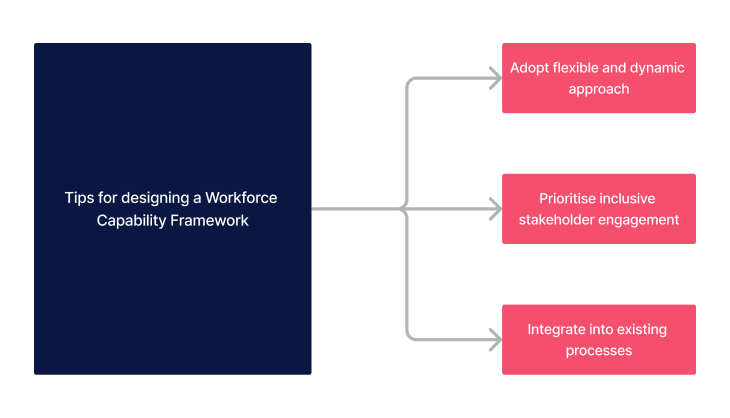What is a Workforce Capability Framework?
A workforce capability framework defines the essential skills, knowledge, and behaviors required for effective performance across various roles within an organisation. In healthcare, it serves as a roadmap for health professionals, outlining the core capabilities necessary for excellence. Beyond identifying technical skills, it emphasises the importance of attitudes, knowledge management, and the adept handling of health information. This strategic tool aids in aligning staff competencies with organisational goals, ensuring a coherent approach to patient care and operational efficiency.
Importance of Workforce Capability Frameworks in Healthcare
Within the ever-evolving landscape of healthcare, capability frameworks play a critical role in ensuring that personnel are equipped with current skills and knowledge. They are particularly crucial in sectors like aged care, primary care, and allied health, where the ability to adapt to changing health conditions and patient demographics is paramount. Frameworks facilitate a structured approach to professional development, ensuring that healthcare workers can provide high-quality care and support. They also help in navigating the complexities of medical histories, health insurance intricacies, and the diverse needs of the population, thereby enhancing the overall effectiveness of the health system.
Examples of Workforce Capability Framework
An exemplary model within this context is the NDIS Workforce Capability Framework, designed to enhance the qualifications of those offering support through Australia's National Disability Insurance Scheme. It underscores competencies vital for delivering personalised, respectful care, including a profound understanding of mental health, advocacy for patient safety, and the promotion of well-being. By setting these standards, the framework ensures that disability care providers are not only competent in their roles but also embody the empathy and respect that underpin high-quality care.
Implementing a Workforce Capability Framework into Your Organisation

Implementing a Workforce Capability Framework is a strategic initiative that requires thoughtful planning, ongoing engagement, and commitment from all levels of the organization. By following these steps, healthcare organizations can enhance their workforce's capabilities, leading to improved patient care and organizational performance.
- Align with organisational goals and ensure the capability framework reflects the skills, knowledge, and behaviors needed to achieve these goals.
- Engage stakeholders across the organisation.
- Integrate into HR processes to embed the framework into recruitment, onboarding, performance management and professional development.
- Develop training and support and allow room for staff to familarise themselves to the framework.
- Implement a pilot program and collect data that can provide key insight and make adjustments before the wider rollout begins.
- Rollout across the organisation.
- Monitor and evaluate the impact of the framework.
- Continuous improvement for ongoing feedback from users.
- Celebrate successes and share experiences.
- Review and refresh the framework to ensure it remains relevant and up-to-date.
How Do You Design a Workforce Capability Framework?
The process of designing a workforce capability framework begins with an in-depth analysis of the specific roles and responsibilities within the healthcare sector. It involves identifying the unique blend of skills, knowledge, and attitudes necessary for these roles, incorporating insights from a broad spectrum of stakeholders. This collaborative approach, engaging health professionals, the Department of Health, and other relevant entities, ensures that the framework accurately reflects the needs and priorities of the health system. It aims to capture the dynamic nature of healthcare, preparing the workforce for current challenges and future advancements.
Steps to Designing a Workforce Capability Framework

- Initiate a comprehensive needs analysis to pinpoint the capabilities essential for various healthcare roles, taking into account emerging trends and future directions.
- Facilitate stakeholder engagement sessions to gather diverse perspectives, including those of health professionals, patients, and health service managers, ensuring the framework is grounded in real-world needs.
- Outline a structured framework, categorising capabilities into distinct domains such as clinical proficiency, effective communication, leadership acumen, and the ethical management of health information.
- Conduct pilot tests of the framework in selected health services or departments to validate its effectiveness and applicability, incorporating feedback for refinement.
- Implement the framework systematically across the organization, embedding it into key HR processes like recruitment, performance management, and ongoing professional development to foster a culture of continuous improvement.
Want a healthcare LMS that can support learning your workforce capability frameworks?
Contact Ausmed today and see how we can support your organisation!
Benefits and Negatives of Designing a Workforce Capability Framework
Implementing a workforce capability framework offers numerous benefits, including enhanced patient care, a more engaged and competent workforce, and clearer career development pathways. However, the development and implementation phases can be resource-intensive, requiring significant time and financial investment.
| Benefits | Negatives |
|---|---|
| Improves patient quality of care. | Time and resources required for development and implementation. |
| Improved staff development and retention. | Potential resistance from staff. |
| Clear pathway for career progression within the health system. | Need for ongoing updates to keep the framework relevant. |
| Framework puts consumers, carers and families at the centre. |
Tips for Designing a Workforce Capability Framework

- Adopt a flexible and dynamic approach to the framework's design to accommodate future healthcare trends and workforce needs.
- Prioritise inclusive stakeholder engagement to ensure the framework resonates with the needs and expectations of all user groups, fostering a sense of ownership and commitment.
- Integrate the framework seamlessly into existing organisational structures and processes, enhancing its relevance and ensuring it becomes an integral part of the organisational culture.
Tools for Designing a Workforce Capability Framework
Designing an effective framework can be facilitated by various tools and technologies. Competency mapping software, for example, can help in identifying and organising the skills and knowledge required for different roles. Stakeholder analysis tools enable a deeper understanding of the needs and expectations of various groups, while collaborative platforms support the iterative development and refinement of the framework. Leveraging these tools can simplify the design process, making it more efficient and effective.
Related Resources
- LMS in Healthcare: The Roles, Benefits and Pros and Cons
- What Are Learning Analytics?
- A Step-by-Step Guide to Data Collection for Learning Analytics
- What Are the Key Learning Analytics Metrics?
- How to Create a Culture of Continuous Learning
- Guide to Compliance Training (for Healthcare Managers)
- Guide to Building a Competency Framework for Skill Development
- How to Manage an Effective Staff Training Program
- Identifying Skills Gaps with Learning Analytics
- A Guide to Personalised Learning in Healthcare
Conclusion
Creating a workforce capability framework is a strategic endeavor with the potential to significantly elevate the standard of healthcare delivery. Through careful planning, stakeholder engagement, and the application of suitable tools, education and development managers can develop a framework that ensures their teams are well-prepared to meet the demands of modern healthcare. Such frameworks not only benefit the workforce with clear guidance and development opportunities but also contribute to the broader goal of enhancing patient care and health system efficiency.
References
- Australian Digital Health Agency 2024, Workforce Capability, Digital Health, https://www.digitalhealth.gov.au/healthcare-providers/initiatives-and-programs/workforce-capability.
- Department of Health (2023). National Disability Insurance Scheme (NDIS) Workforce Capability Framework.
- Health Workforce Australia (2022). Health Workforce Capability Framework: A Guide for Managers and Professionals.



